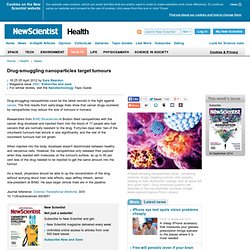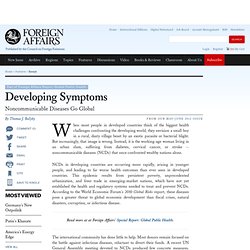

Could This Be The End Of Cancer? Old Cancer Drugs Offer New Tricks. Drug-smuggling nanoparticles target tumours - health - 05 April 2012. Drug-smuggling nanoparticles could be the latest recruits in the fight against cancer.

The first results from early-stage trials show that cancer drugs couriered by nanoparticles may reduce the size of tumours in humans. Researchers from BIND Biosciences in Boston filled nanoparticles with the cancer drug docetaxel and injected them into the blood of 17 people who had cancers that are normally resistant to the drug. Forty-two days later, two of the volunteers' tumours had shrunk in size significantly, and the rest of the volunteers' tumours had not grown.
When injected into the body, docetaxel doesn't discriminate between healthy and cancerous cells. However, the nanoparticles only released their payload when they reacted with molecules on the tumour's surface, so up to 80 per cent less of the drug needed to be injected to get the same amount into the tumour.
Journal reference: Science Translational Medicine, DOI: 10.1126/scitranslmed.3003651 New Scientist Not just a website! Clues to aspirin's anti-cancer effects revealed - health - 19 April 2012. One of the world's oldest medicines may hold the secret to a very contemporary problem: preventing cancer.

Exactly why salicylate shows such potential as an anti-cancer treatment remains unclear, but a new study in mice offers clues. Salicylate, found in willow bark, has been a key ingredient in medicine cabinets for thousands of years – ancient Egyptian manuscripts describe it as a treatment for inflammation. In a modified form – aspirin – it remains a successful anti-inflammatory and analgesic.
Recently, though, research has revealed a puzzling side-effect of taking aspirin: the drug seems to lower a person's chances of developing some forms of cancer. "Cancer by the Numbers" by John Allen Paulos. Exit from comment view mode.

Click to hide this space PHILADELPHIA – It is difficult to communicate medical risk to a large audience, especially when official recommendations conflict with emotional narratives. That is why, when the United States Preventive Services Task Force (USPSTF) in 2009 presented its guidelines for breast cancer screening, which recommended against routine screenings for asymptomatic women in their 40’s and biennial, rather than annual, mammograms for women over 50, the public responded with confused fury.
The Miraculous NASA Breakthrough That Could Save Millions of Lives (UPDATED) A world within a tumour – new study shows just how complex cancer can be. When I used to work at a cancer charity, I would often hear people asking why there isn’t a cure yet.

This frustration is understandable. Developing Symptoms. When most people in developed countries think of the biggest health challenges confronting the developing world, they envision a small boy in a rural, dusty village beset by an exotic parasite or bacterial blight.

But increasingly, that image is wrong. Instead, it is the working-age woman living in an urban slum, suffering from diabetes, cervical cancer, or stroke -- noncommunicable diseases (NCDs) that once confronted wealthy nations alone. NCDs in developing countries are occurring more rapidly, arising in younger people, and leading to far worse health outcomes than ever seen in developed countries. This epidemic results from persistent poverty, unprecedented urbanization, and freer trade in emerging-market nations, which have not yet established the health and regulatory systems needed to treat and prevent NCDs.
Read more at at Foreign Affairs' Special Report: Global Public Health. The international community has done little to help. To continue reading, please log in. Register. Neighborhood Linked To Obesity. Diabetes Mystery: Why are Type 1 Cases Surging? When public health officials fret about the soaring incidence of diabetes in the U.S. and worldwide, they are generally referring to type 2 diabetes.

About 90 percent of the nearly 350 million people around the world who have diabetes suffer from the type 2 form of the illness, which mostly starts causing problems in the 40s and 50s and is tied to the stress that extra pounds place on the body’s ability to regulate blood glucose. About 25 million people in the U.S. have type 2 diabetes, and another million have type 1 diabetes, which typically strikes in childhood and can be controlled only with daily doses of insulin.
For reasons that are completely mysterious, however, the incidence of type 1 diabetes has been increasing throughout the globe at rates that range from 3 to 5 percent a year. Procedure Offers Hope In Type 1 Diabetes. Murder trial highlights return of Dickensian killer - health - 05 January 2012. Editorial: "Down with this Dickensian disease" LAST month, Rohan Wray and Chana Al-Alas walked free from the Old Bailey court in London after being cleared of killing their 4-month-old son Jayden in 2009.

The injuries to his skull, knee, elbow, shoulder, hip, ankle and wrist - and haemorrhages in his skull and eyes - had seemed to suggest that the pair was responsible for their baby's death. Post-mortems revealed a different story. Jayden had rickets, a Dickensian disease caused by a shortage of vitamin D, making his bones abnormally weak and vulnerable to damage.